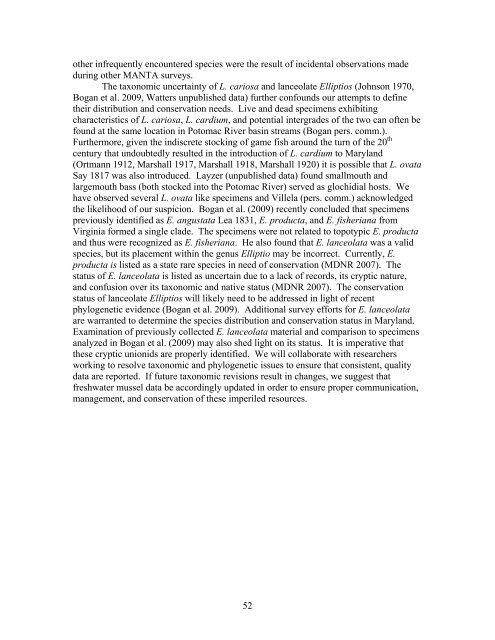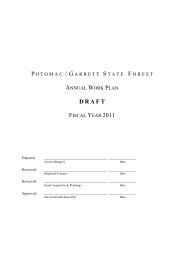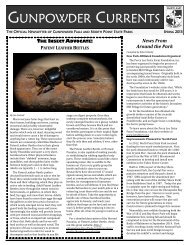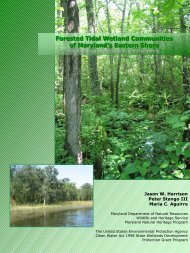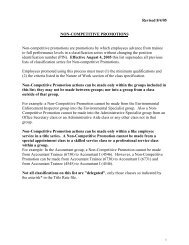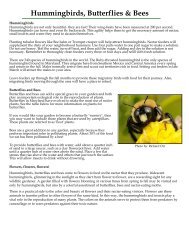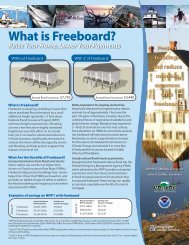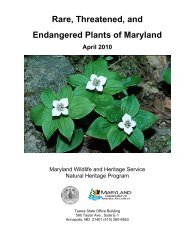Freshwater mussel records collected by the Maryland Department of ...
Freshwater mussel records collected by the Maryland Department of ...
Freshwater mussel records collected by the Maryland Department of ...
You also want an ePaper? Increase the reach of your titles
YUMPU automatically turns print PDFs into web optimized ePapers that Google loves.
o<strong>the</strong>r infrequently encountered species were <strong>the</strong> result <strong>of</strong> incidental observations made<br />
during o<strong>the</strong>r MANTA surveys.<br />
The taxonomic uncertainty <strong>of</strong> L. cariosa and lanceolate Elliptios (Johnson 1970,<br />
Bogan et al. 2009, Watters unpublished data) fur<strong>the</strong>r confounds our attempts to define<br />
<strong>the</strong>ir distribution and conservation needs. Live and dead specimens exhibiting<br />
characteristics <strong>of</strong> L. cariosa, L. cardium, and potential intergrades <strong>of</strong> <strong>the</strong> two can <strong>of</strong>ten be<br />
found at <strong>the</strong> same location in Potomac River basin streams (Bogan pers. comm.).<br />
Fur<strong>the</strong>rmore, given <strong>the</strong> indiscrete stocking <strong>of</strong> game fish around <strong>the</strong> turn <strong>of</strong> <strong>the</strong> 20 th<br />
century that undoubtedly resulted in <strong>the</strong> introduction <strong>of</strong> L. cardium to <strong>Maryland</strong><br />
(Ortmann 1912, Marshall 1917, Marshall 1918, Marshall 1920) it is possible that L. ovata<br />
Say 1817 was also introduced. Layzer (unpublished data) found smallmouth and<br />
largemouth bass (both stocked into <strong>the</strong> Potomac River) served as glochidial hosts. We<br />
have observed several L. ovata like specimens and Villela (pers. comm.) acknowledged<br />
<strong>the</strong> likelihood <strong>of</strong> our suspicion. Bogan et al. (2009) recently concluded that specimens<br />
previously identified as E. angustata Lea 1831, E. producta, and E. fisheriana from<br />
Virginia formed a single clade. The specimens were not related to topotypic E. producta<br />
and thus were recognized as E. fisheriana. He also found that E. lanceolata was a valid<br />
species, but its placement within <strong>the</strong> genus Elliptio may be incorrect. Currently, E.<br />
producta is listed as a state rare species in need <strong>of</strong> conservation (MDNR 2007). The<br />
status <strong>of</strong> E. lanceolata is listed as uncertain due to a lack <strong>of</strong> <strong>records</strong>, its cryptic nature,<br />
and confusion over its taxonomic and native status (MDNR 2007). The conservation<br />
status <strong>of</strong> lanceolate Elliptios will likely need to be addressed in light <strong>of</strong> recent<br />
phylogenetic evidence (Bogan et al. 2009). Additional survey efforts for E. lanceolata<br />
are warranted to determine <strong>the</strong> species distribution and conservation status in <strong>Maryland</strong>.<br />
Examination <strong>of</strong> previously <strong>collected</strong> E. lanceolata material and comparison to specimens<br />
analyzed in Bogan et al. (2009) may also shed light on its status. It is imperative that<br />
<strong>the</strong>se cryptic unionids are properly identified. We will collaborate with researchers<br />
working to resolve taxonomic and phylogenetic issues to ensure that consistent, quality<br />
data are reported. If future taxonomic revisions result in changes, we suggest that<br />
freshwater <strong>mussel</strong> data be accordingly updated in order to ensure proper communication,<br />
management, and conservation <strong>of</strong> <strong>the</strong>se imperiled resources.<br />
52


